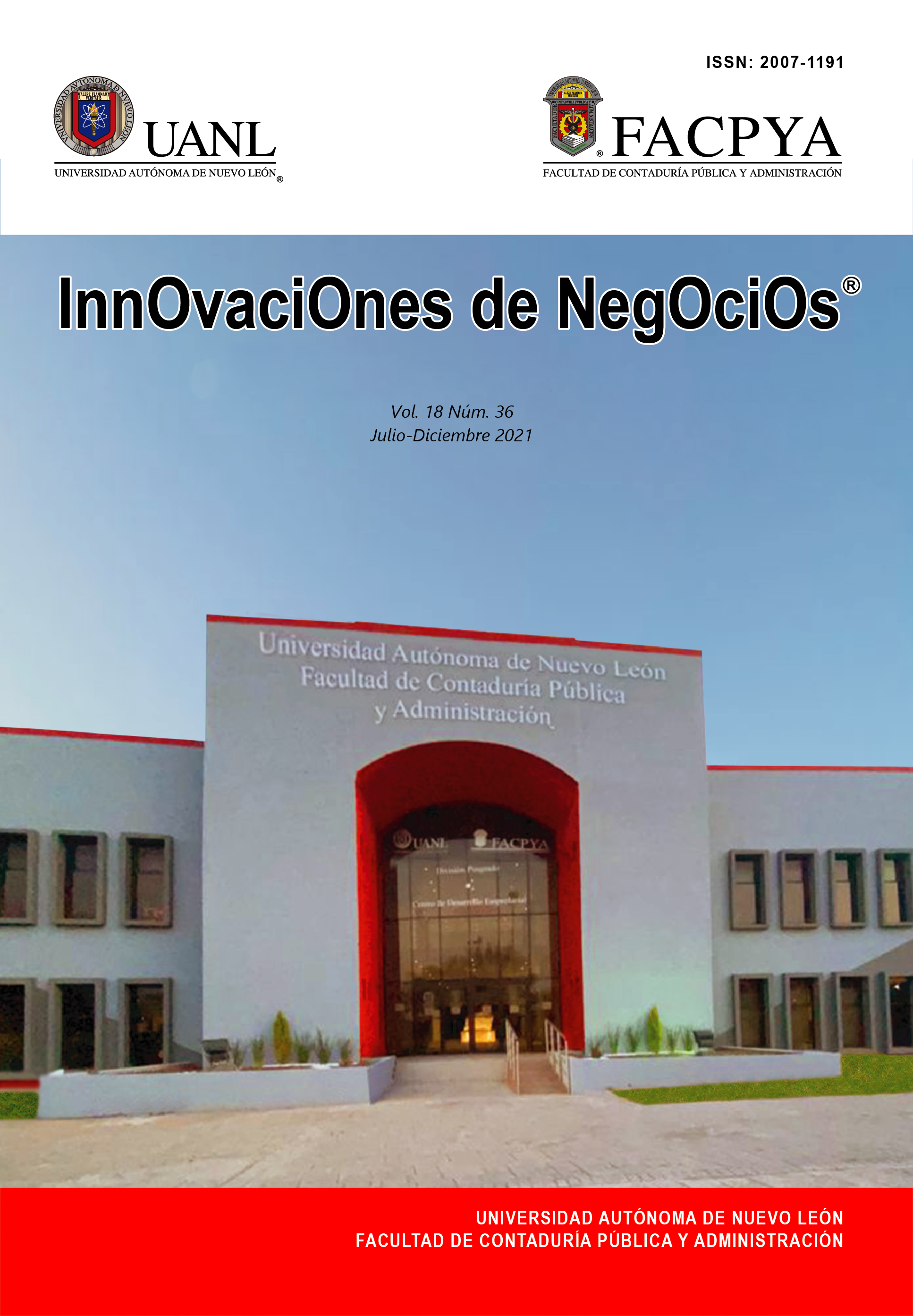Content validity and reliability of a measurement instrument to determine the psychosociological factors that impact the purchase intention of foreign products in Mexican consumers
DOI:
https://doi.org/10.29105/rinn18.36-3Keywords:
cosmopolitanism, country of origin image, foreign brands image, intention to purchase foreign products, xenocentrismAbstract
In this research, a measurement instrument related to variables in the area of psychology and sociology was created to measure the relationship between the variables and contribute to the determination of the psychosociological factors
that impact on the purchase intention of foreign products in Mexicans consumers, which made it possible to fulfill the objective of this investigation. This measurement instrument was validated by several experts in the research area and was considered reliable based on the results of the Cronbach's Alpha test because the coefficients are in a range from 0.84 to 0.95. The validated and reliable instrument was finally made up of 67 items. Therefore, it is of utmost importance
that before surveying the target population, the content validity is determined and the relevant reliability analyzes are carried out in order to eliminate items that do not measure what they should really measure.
Downloads
References
Aghekyan-Simonian, M., Forsythe, S., Kwon, W. S., & Chattaraman, V. (2012). The role of product brand image and online store image on perceived risks and online purchase intentions for apparel. Journal of Retailing and Consumer Services, 19(3), 325–331. doi: 10.1016/j.jretconser.2012.03.006
Ansary, A., & Hashim, N. (2018). Brand image and equity: the mediating role of brand equity drivers and moderating effects of product type and word of mouth. Review of Managerial Science, 12(4), 969–1002. doi: 10.1007/s11846-017-0235-2
Balabanis, G., & Diamantopoulos, A. (2016). Consumer Xenocentrism as Determinant of Foreign Product Preference: A System Justification Perspective. Journal of International Marketing, 24(3), 58–77. doi: 10.1509/jim.15.0138
Batra, R., Ramaswamy, V., Alden, D. L., Steenkamp, J. B. E. M., & Ramachander, S. (2000). Effects of Brand Local and Nonlocal Origin on Consumer Attitudes in Developing Countries. Journal of Consumer Psychology, 9(2), 83–95. doi: 10.1207/s15327663jcp0902_3
Cannon, H. M., & Yaprak, A. (2002). Will the real-world citizen please stand up! The many faces of cosmopolitan consumer behavior. Journal of International Marketing, 10(4), 30–52. doi: 10.1509/jimk.10.4.30.19550
Cho, E., Fiore, A. M., & Russell, D. (2015). Validation of a Fashion Brand Image Scale Capturing Cognitive, Sensory, and Affective Associations: Testing Its Role in an Extended Brand Equity Model Eunjoo. Psychology & Marketing, 32(1), 28–48. doi: 10.1002/mar
Conner, S. L., Reardon, J., Miller, C., Salciuviene, L., & Auruskeviciene, V. (2017). Cultural antecedents to the normative, affective, and cognitive effects of domestic versus foreign purchase behavior. Journal of Business Economics and Management, 18(1), 100–115. doi: 10.3846/16111699.2016.1220975
Darling, J. R., & Arnold, D. R. (1988). The Competitive Position Abroad Of Products And Marketing Practices Of The United States, Japan, And Selected European Countries. Journal of Consumer Marketing, 5(4), 61–68. doi: 10.1108/eb008239
Diamantopoulos, A., Schlegelmilch, B., & Palihawadana, D. (2011). The relationship between country-of-origin image and brand image as drivers of purchase intentions: A test of alternative perspectives. International Marketing Review, 28(5), 508–524. doi: 10.1108/02651331111167624
Dobni, D., & Zinkhan, G. M. (1990). In search of brand image: A foundation analysis. Advances in Consumer Research, 17(110–119).
Dodds, W. B., Monroe, K. B., & Grewal, D. (1991). Effects of Price, Brand, and Store Information on Buyers’ Product Evaluations. Journal of Marketing Research, 28(3), 307–319. doi: 10.2307/3172866
Hernández, R., Fernández, C., & Baptista, M. del P. (2010). Metodología de la investigación (5 ed.). McGraw-Hill.
INEGI. (2020). Indicadores estratégicos de ocupación y empleo. Retrieved April 23, 2020, from https://www.inegi.org.mx/
Infosino, W. (1986). Forecasting New Product Sales from Likelihood of Purchase Ratings. Marketing Science, 5(4), 372–384. doi: 10.1287/mnsc.16.2.b148
Insch, G. S., & McBride, J. B. (2004). The impact of country-of-origin cues on consumer perceptions of product quality: A binational test of the decomposed country-of-origin construct. Journal of Business Research, 57(3), 256–265. doi: 10.1016/S0148-2963(02)00323-5
Klein, J. G., Ettenson, R., & Morris, M. D. (1998). The Animosity Model of Foreign Product Purchase: An Empirical Test in the People’s Republic of China. Journal of Marketing, 62(1), 89–100. doi: 10.2307/1251805
Laroche, M., Papadopoulos, N., Heslop, L. A., & Mourali, M. (2005). The influence of country image structure on consumer evaluations of foreign products. International Marketing Review, 22(1), 96–115. doi: 10.1108/02651330510581190
Lassar, W., Mittal, B., & Sharma, A. (1995). Measuring customer-based brand equity. Journal of Consumer Marketing, 12(4), 11–19. doi: http://dx.doi.org/10.1108/07363769510095270
Lawrence, S. J. (2012). Consumer Xenocentrism and Consumer Cosmopolitanism: The Development and Validation of Scales of Constructs Influencing Attitudes Towards Foreign Product Consumption. ProQuest Dissertations and Theses, 179.
Li, X., Yang, J., Wang, X., & Lei, D. (2012). The impact of country-of-origin image, consumer ethnocentrism and animosity on purchase intention. Journal of Software, 7(10), 2263–2268. doi: 10.4304/jsw.7.10.2263-2268
Mendoza, J., & Garza, J. B. (2009). La medición en el proceso de investigación científica: Evaluación de validez de contenido y confiabilidad. Innovaciones de Negocios, 6(1), 17–32. doi: 10.1017/CBO9781107415324.004
Morrison, D. G. (1979). Purchase Intentions and Purchase Behavior. Journal of Marketing, 43(2), 65–74. doi: 10.1177/002224297904300207
Mueller, R. D., & Broderick, A. J. (2008). Consumer Xenocentrism: An Alternative Explanation for Foreign Product Bias. In Proceedings of Annual Hawaii International Business Research Conference. doi: 10.1108/APJML-11-2014-0158
Nguyen, T., Nguyen, T., & Barrett, N. (2008). Consumer ethnocentrism, cultural sensitivity, and intention to purchase local products—evidence from Vietnam. Journal of Consumer Behaviour, 88–100. doi: 10.1002/cb
Parts, O., & Vida, I. (2011). The effects of consumer cosmopolitanism on purchase behavior of foreign vs. domestic products. Managing Global Transitions, 9(4), 355–370.
Riefler, P., & Diamantopoulos, A. (2009). Consumer cosmopolitanism: Review and replication of the CYMYC scale. Journal of Business Research, 62(4), 407–419. doi: 10.1016/j.jbusres.2008.01.041
Riefler, P., Diamantopoulos, A., & Siguaw, J. A. (2012). Cosmopolitan consumers as a target group for segmentation. Journal of International Business Studies, 43(3), 285–305. doi: 10.1057/jibs.2011.51
Rositas, J. (2014). Los tamanos de las muestras en encuestas de las ciencias sociales y su repercusion en la generacion del conocimiento. Innovaciones de Negocios, 11(22), 235–268. Retrieved from http://www.web.facpya.uanl.mx/rev_in/Revistas/11_22/11.22 Art4 pp 235 - 268.pdf
Rositas, J., Alarcón, G., & Badii, M. H. (2006). El desarrollo y evaluación de la declaración del problema de investigación. Innovaciones de Negocios, 3(2), 331–345.
Roth, K. P., & Diamantopoulos, A. (2009). Advancing the country image construct. Journal of Business Research, 62(7), 726–740. doi: 10.1016/j.jbusres.2008.05.014
Roy, D., & Banerjee, S. (2008). Care-ing strategy for integration of brand identity with brand image. International Journal of Commerce and Management, 17(1–2), 140–148. doi: 10.1108/10569210710776512
Salehzadeh, R., Pool, J. K., & Najafabadi, A. H. J. (2018). Exploring the relationship between corporate social responsibility, brand image and brand equity in Iranian banking industry. Journal of Islamic Accounting and Business Research. Journal of Islamic Accounting and Business Research., 1–33.
Saran, A., & Kalliny, M. (2012). Cosmopolitanism: Concept and Measurement. Journal of Global Marketing, 25(5), 282–291. doi: 10.1080/08911762.2012.779196
Schiffman, L. G., & Lazar, L. (2010). Comportamiento del consumidor (10 ed.). México: Pearson Educación.
Sweeney, J. C., & Soutar, G. N. (2001). Consumer perceived value: The development of a multiple item scale. Journal of Retailing, 77(21), 203–220.
Torres, N., & Gutiérrez, S. (2013). El perfil psico-sociológico y demográfico del consumidor mexicano. Estudios Demográficos y Urbanos, 28(3), 681–710. doi: 10.24201/edu.v28i3.1450
Verlegh, P. W. J. (2001). Country-of-origin effects on consumer product evaluations. In Marketing and consumer behaviour. doi: 90-5808-463-9
Wang, C.-K., & Lamb, C. (1983). The impact of selected environmental forces upon consumers’ willingness to buy foreign products. Journal of the Academy of Marketing Science, 11(1–2), 71–84. doi: 10.1007/BF02721862
Downloads
Published
How to Cite
Issue
Section
License
Copyright (c) 2021 Innovaciones de Negocios

This work is licensed under a Creative Commons Attribution-NonCommercial-ShareAlike 4.0 International License.
The InnOvaciOnes de NegOciOs magazine is a free and open access electronic magazine of a scientific-academic nature and is a publication of the Autonomous University of Nuevo León, in which the authors retain their copyright and grant the magazine the exclusive right to first publication of the work. Third parties are allowed to use the published content, as long as the authorship of the work is acknowledged and the first publication in this journal is cited.
For more information, please contact the Research Secretary (FACPyA) of the Autonomous University of Nuevo León. Telephone: (81) 1340-4430. Email: revinnova@uanl.mx










